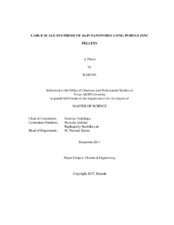| dc.description.abstract | Nanowires are nanostructures with diameters on the order of a few nanometers with an aspect ratio greater than 1000. A major challenge impeding commercialization of nanowires and nanowire-based devices is their large-scale synthesis.
Traditionally nanowires synthesized by chemical vapor deposition (CVD) are grown via the vapor-liquid-solid (VLS) mechanism using expensive catalysts, and these catalysts remain as contaminants after the synthesis. This problem can be avoided by using self-catalysis, where one of the component elements of the nanowires serves as the catalyst. Brockway et al. have used self-catalysis and have reported gram-scale synthesis of Znv3Pv2 nanowires using this strategy. In that work, zinc foils served as both the source and the substrate for the formation of Znv3Pv2 nanowires. However, using this method the growth of nanowires is constrained to the surfaces of the zinc foils thereby reducing the number of nanowires produced. In addition, post-synthesis nanowire collection involves brushing Znv3Pv2 nanowires out of zinc foils, which is physically difficult and time intensive.
The objective of this thesis is to convert entire zinc raw material into Znv3Pv2 nanowires in a byproduct-free manner. This has been accomplished by using Zn/NHv4Cl pellets, as pellets have better thermal transport than powdered form, leading to uniform heat distribution. In addition, in the early stages of heating, NH4Cl sublimates leaving behind porous Zn pellets which aids the diffusion of phosphorus vapors throughout out the pellet. Thus, entire pellets are converted into Zn3P2 nanowires avoiding the post-synthesis nanowire collection. X-ray diffraction analysis confirmed that resulting Znv3Pv2 nanowires were devoid of any impurities such as Zn, ZnO, ZnClv2 or NHv4Cl. | en |


